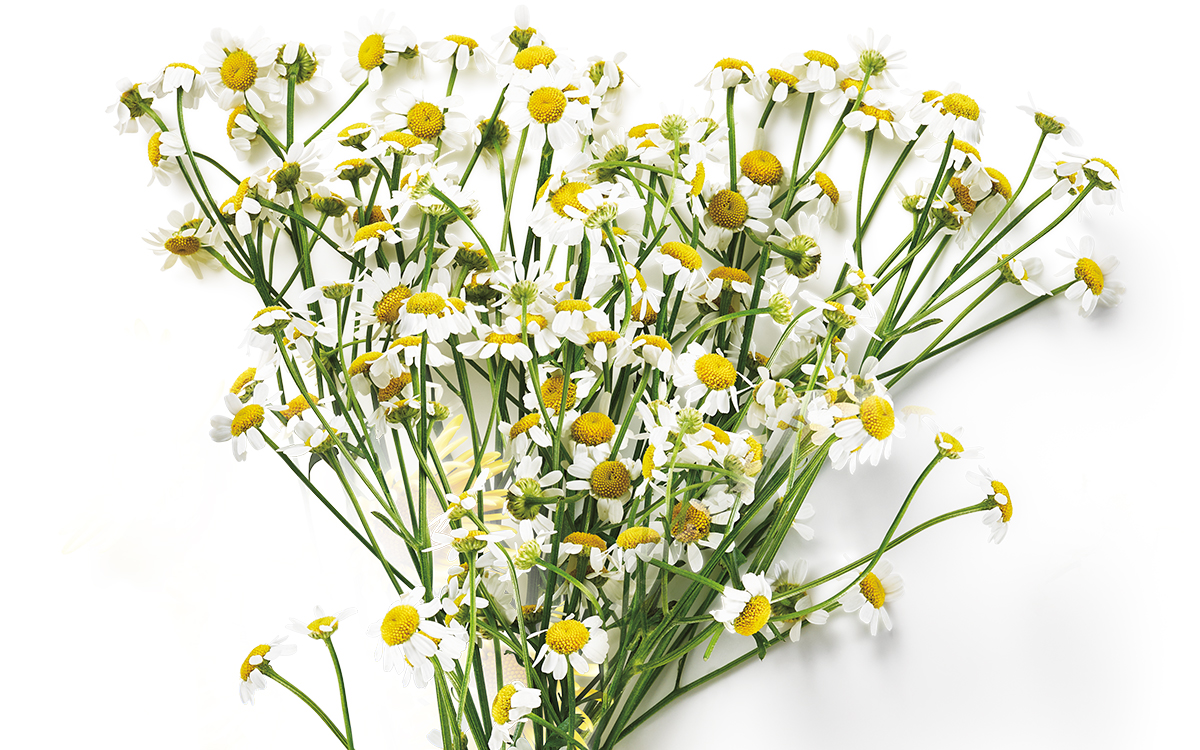Ingredient Spotlight: Chamomile

When you think of Chamomile, sturdy mugs of steaming tea probably come to mind. Chamomile isn’t just a pre-bedtime ritual, though. With its white and yellow buds, this sweet-smelling herb is a member of the daisy family and has been used for thousands of years to calm minds, remedy colds and help with digestive issues. In fact, Chamomile is considered one of the most ancient medicinal botanical ingredients known to humans, which speaks volumes about its potency.
Chamomile has also been utilized topically for just as long. Below we’ve outlined the many ways in which Chamomile can help improve your skin, which skin types benefit from it most, and a few product recommendations. Now, let’s dive into this botanical hero.
How Chamomile Can Benefit Your Skin
“Chamomile Extract is a powerful anti-inflammatory agent that can help to decongest clogged pores, decrease eczema, soothe dermatitis, improve skin’s natural glow and even speed the healing of burns,” says Sarah Akram, a board-certified master aesthetician based in D.C. and NYC. “It not only reduces inflammation, but also cleanses and moisturizes the skin while soothing irritation. When added to other skincare products, Chamomile Extract can even increase the efficacy of creams and lotions.”
You’ll typically see Chamomile listed as either an extract, essential oil or tea when it’s incorporated into skincare products. You may also see some of its primary components listed, which are extracted from the plant itself. “The primary component of the Chamomile Essential Oil is Bisabolol, which is very high in Panthenol. This is what promotes healing and improves skin penetration of other skincare products. Bisabolol has also been shown to improve hyperpigmentation,” notes Dr. Jenny Sobera, the chief medical officer for FaceMD+. “Another Chamomile Extract is Azulene, which is used as a blue dye and is found in many skincare products.”
Azulene is also known for its soothing abilities — especially for dry, damaged, and sensitive skin — and is a powerful antioxidant. Speaking of antioxidants, Akram says that Chamomile is also rich in Flavonoids, the antioxidants that protect the skin from free radical damage. That means that your skin is less susceptible to the premature aging that’s caused by environmental pollutants and UV rays. Flavonoids can also help decrease redness and itching.
Skin Types That Benefit Most from Chamomile
As you probably guessed from the praise above, Chamomile-infused skincare products are ideal for those with blemish and acne-prone skin. And not to get dramatic or anything, but according to Akram, Chamomile is actually considered “one of the best herbal extracts for treating acne,” who notes that if you’re on prescription drugs, you should check with your doctor before introducing Chamomile to your routine.
So you might not be surprised to hear that the bareMinerals BLEMISH RESCUE Collection features this wonder-plant. The line includes an Anti-Redness Mattifying Primer, which helps zap oil and acne while soothing skin; Skin-Clearing Spot Concealer, which covers and heals acne at the same time; and Skin-Clearing Loose Powder Foundation, a mineral foundation that’s been clinically shown to reduce acne in under one month.
All that said, Chamomile is recommended for anyone with sensitive skin, those who have eczema, and anyone whose skincare goals include reducing hyperpigmentation or preventing free radical damage.
When and How to Apply Chamomile-Infused Products
Because Chamomile is high in antioxidants, it’s wise to apply it in the morning, before your sunscreen, to protect your skin from damage. Because it’s such a soothing ingredient, it also works well when applied in the evening. Ultimately, when you apply — and how often — depends on the product itself. For example, BLEMISH RESCUE makeup is intended to be used in the morning (though anyone can apply makeup at night too, obviously). Chamomile-infused products like moisturizers, ointments, oils, and creams may be better when applied before going to sleep.
In addition to formulated products, Dr. Sobera recommends two DIY treatments with the Chamomile tea in your pantry. You can steep tea, adding a splash of honey, and, once it has cooled safely, apply it as a warm compress over your entire face. You can also make a soothing, healing mask by combining equal parts dried Chamomile Flowers with Honey, Oatmeal and Olive Oil. Mix the paste, apply, let it set for 15 minutes, then rinse. This ancient herb has proven itself over thousands of years to heal, soothe, and improve skin. Go wild!
Love learning about beauty ingredients? Check out our ingredient spotlights on Coconut Alkanes and Peony, and stay tuned for more.





